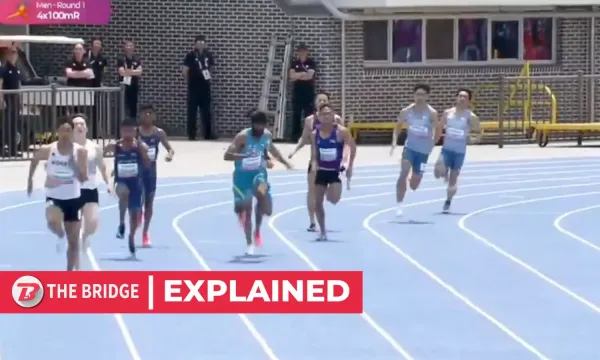
India’s men’s 4x100m relay team was disqualified during the heats at the Asian Athletics Championships 2025 in Gumi — a major blow for a squad that had entered the tournament as one of the top contenders.
Just a month ago, Indian athletics was celebrating a historic moment.
At the Indian Open Relay competition in Chandigarh, the quartet of Gurindervir Singh, Animesh Kujur, Manikanta Hoblidhar, and Amlan Borgohain broke the 15-year-old national record in the men’s 4x100m relay.
Clocking 38.69 seconds, they not only set a new Indian benchmark but also registered the fastest 4x100m time in Asia this year, bettering their own earlier timing of 38.93s from the heats of the same event.
Heading into the Asian Championships, expectations were sky-high. Even though the lineup saw changes, with Pranav Gurav and Ragul Kumar joining Manikanta and Amlan, the team was still viewed as a serious medal threat.
What went wrong?
Unfortunately, India’s campaign came to an abrupt end during the first baton exchange between Pranav Gurav and Ragul Kumar, where the baton was passed outside the designated takeover zone. This violation led to an immediate disqualification under international relay rules.
In sprint relays, the baton exchange is as critical as the sprinting itself. Even teams with slower individual runners can outpace faster squads by executing seamless, legal exchanges.
So what exactly is this “takeover zone,” and why is it so important?
What is the Takeover Zone, and why does it matter?
According to World Athletics Rule TR24.7, a baton exchange must occur within a fixed 20-meter takeover zone. This zone is clearly marked on the track.
The baton must be received by the outgoing runner within this zone, not before or after. If the baton changes hands even slightly outside this boundary, the team is automatically disqualified, regardless of performance.
Rule TR24.7 (World Athletics):
“The baton shall be passed within the takeover zone. The passing of the baton commences when it is first touched by the receiving athlete and is completed the moment it is in the hand of only the receiving athlete. Passing of the baton outside the takeover zone shall result in disqualification.”
This rule is strictly enforced in international competitions to ensure fair play and standardization across all teams.
Each takeover zone is preceded by a 10-meter acceleration zone. In this area, the outgoing runner is allowed to start sprinting to match the incoming runner’s speed, but the baton cannot be exchanged here. The goal is to build momentum without violating the rule.
Here the area marked in red is the Baton exchange zone (Image credit: Athletic coaching)
Here’s how the mechanics typically work:
Runner 1 starts in blocks and holds the baton in their right hand.
Runner 2 receives it in the left, Runner 3 switches back to the right, and the final leg is run with the left again.
This alternation prevents runners from needing to switch hands mid-race, which would waste time and increase risk of error.
These exchanges are practiced to perfection, often with athletes marking specific spots on the track, based on stride length, to begin their acceleration. But on race day, even a few miscalculated steps can push the baton exchange outside the legal zone, as happened with India in Gumi.
While heartbreaking, especially for fans and the athletes themselves, the disqualification serves as a reminder of how fine the margins are in elite athletics. A single misstep, even by inches, can override months of preparation and peak performance.
India’s quartet of Pranav Pramod Gurav, Ragul Kumar Ganesh Kumar, Manikanta Hoblidhar, and Amlan Borgohain had the speed, the form, and the potential — but not the perfect baton pass when it mattered most.